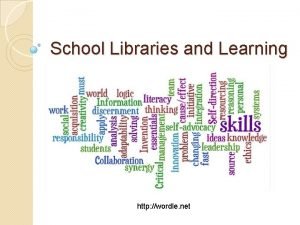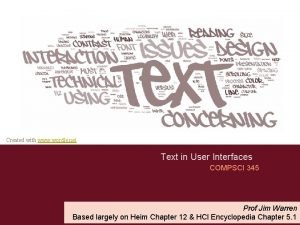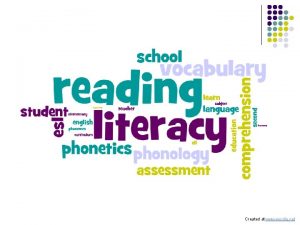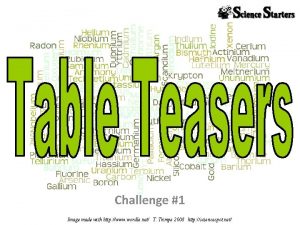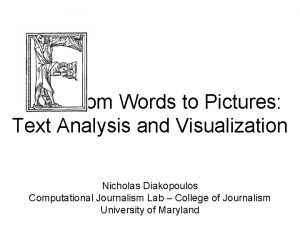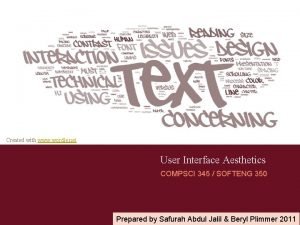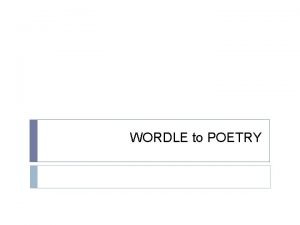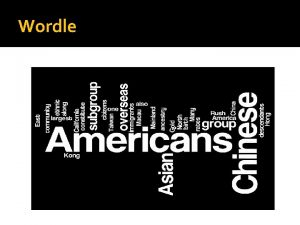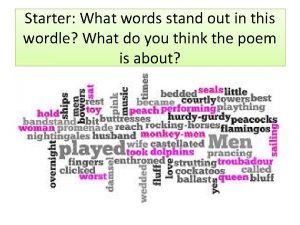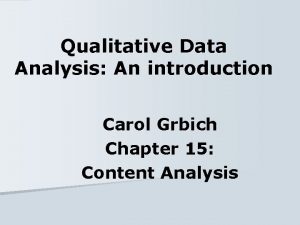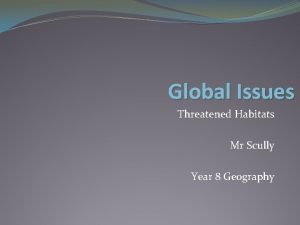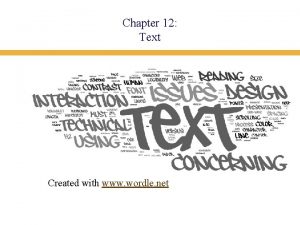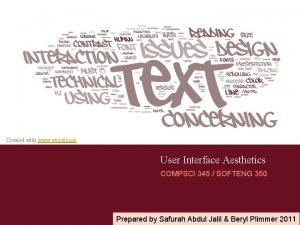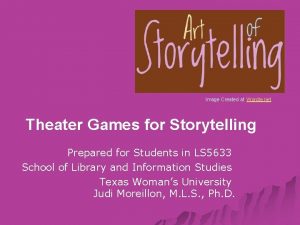Created with www wordle net Text in User
























- Slides: 24

Created with www. wordle. net Text in User Interfaces COMPSCI 345 Prof Jim Warren Based largely on Heim Chapter 12 & HCI Encyclopedia Chapter 5. 1

2 Learning Outcomes n Describe the main purposes of text in user interface designs n Appreciate the balance between art fonts and readability n Explain what makes a font readable (or not) n Identify and utilise the characteristics of text that we can control n Select an appropriate font scheme for a user interface design

Human Issues n The Reading Purpose Just because there’s a search function doesn’t mean you’ll never scan (e. g. don’t recall a keyword, or are deciding what a passage is about) n Continuous process (reading a novel); scanning n Using text to operate the user interface per se n Reading n Paper offers physical cues that are lost in simple online paradigms such as a scrolling window n n We often rely on our spatial memory when we search for information Paper can be easier to manipulate for reading comfort and ideal viewing (less fatiguing) n n interface - screen or paper Place holders Systems such as Kindle are approaching books on this Then again, electronic is great for having automated search

4 Human Issues n Active reading aids comprehension n Using your pen to follow lines Annotating the text Beryl Plimmer’s group has done quite a lot of annotation research. Have a look here http: //www. cs. auckland. ac. nz/research/hci/digital_ink/annotation_tools/index. shtml

Text in Interaction Design n Commentary/Instrumental text in UI n Commentary text informs user of system status n Instrumental text is text that works; e. g. hyperlinks, button, labels/captions (more on these in lecture on forms & controls) n Whether n n n it’s body content or part of UI: Legibility n Can the reader discern the words? Readability n Can the reader easily read the text? Physical Factors n What is the screen resolution, brightness?

6 Remember the reading process n We read lowercase more quickly than UPPERCASE n Uppercase good for picking out specific word or characters at a distance n Lowercase presentation is more common n Except when people don’t want you to read it Do they want you to read the chocolate bar wrapper?

7 Typography craft and an art n Art Book of Kells (6 th century) n Craft n n n Arranging glyphs (letters) Dates from earliest printing presses Its history is evident in the terms we use n Leading … the amount of lead between lines

+ 8 Basic Anatomy of letterforms Image modified from http: //26. media. tumblr. com/tumblr_kx 1 onh. Pp. D 61 qajttoo 1_500. gif

9 Fonts: serif & sans serif http: //www. pixel 77. com/typography-type-and-typefaces/ ‘Sans’ is “without”, therefore sans serif fonts are fonts without serifs n People still argue whether serif (e. g. Georgia) or sans serif (e. g. Arial) is easier to read on a screen n http: //www. w 3 schools. com/cssref/playit. asp? filename=playcss _font-family n CSS definition: p. ex 2 { font: 15 px Georgia, serif; } Use in HTML: <p class="ex 2">Georgia</p> n n Georgia, Verdana, and Trebuchet maintain legibility at small sizes and have been designed to facilitate reading on the Web

+ 10 Fonts for title vs. body Decorative/Display fonts n Decorative fonts (sometimes called display fonts or title fonts) n n n suitable for titles and headings strong personality: n grab people’s attention n reinforce the message of the word. May not be installed on all machines – in which case you need to have a default! n Neutral looking fonts such Georgia or Arial are more suitable as body copy (easier to read)

+ 11 Fonts for title vs. body

12 Fonts: proportional & monospaced http: //library. kiwix. org: 4201/A/Typeface. html n A proportional font has variable-width: ioioio n A monospaced font has fixed-width ioioio

13 Half Time Entertainment n http: //www. nzherald. co. nz/business/news/articl e. cfm? c_id=3&objectid=11189192 n Online newspapers circa 1981 n The way we use text with computers has undergone remarkable changes n n n Network advances affecting how much text (and graphics) we get, and hence what we read online Fonts, displays and amount of text we read And it’s recently turned another corner with mobile (and with ubiquity of video)

14 Font Size n n Typically given in points (‘pt’) n 1/72 nd of an inch (about 0. 3528 mm) n 12 points makes a pica (but who cares? ) Size of the ‘em-box’ in points is the point size of the font n Entire height of text in the font, from bottom of the descender to the top of a Cap or ascender n Once equivalent to the width of a letter M in the font, but not necessarily so (incidentally — origin of em dash – and en dash) n Can also give font size in pixels (px) n Displayed size varies by device and settings n Size in points at least means a real specific size when printed (if set to print full size!)

Font Size n Factors that affect perceived font size (in the sense of how well a font of a given size in usable): n n n Reading Distance—Greater distances require larger text. Screen Resolution—Smaller text requires greater resolution to keep the characters clear and legible. Text/Background Contrast—Positive contrast is optimal (black type on a white background for max). Visual Acuity of User—Not all users have 20/20 vision. And from age 40 -something presbyopia really takes hold: focusing on near objects doesn’t work so well and hence small fonts require magnification Purpose —Text can be scanned, read word by word, or read character by character [e. g. passwords]

16 Font Size n Fonts for body copy usually don't work well when set too large, they tend to become inelegant and clunky. n The opposite is the case when setting titling fonts too small – the title/heading will lose its dominance and the page looks bland.

17 Font Size n Fonts of the same size, say 11 pt, will sometimes look different in size due to their different x-heights. http: //www. pixel 77. com/typography-type-and-typefaces/ n These fonts are all in the same size (36 pt): aaaa Looks bigger Looks smaller n http: //www. w 3 schools. com/cssref/tryit. asp? filename=try css_font with p. ex 1 { font: 15 px Times New Roman, serif; } p. ex 2 { font: 15 px Book Antiqua, serif; }

Weight & Style n Weight n Bold When two fonts differ in weight, they form a strong and vibrant visual contrast. e. g. between heading, and body – as we have on this page n Style n n Italics Underline n Underlines will be mistaken as a hyperlink n so don’t use except for links… except sometimes in lecture slides n Besides emphasizing points, creating contrast by varying weight and style can contribute to a dramatic and eye-catching look to an interface. It helps keep your page from looking dull. n However, use with restraint and be consistent. n too many weight and styles on one screen gets confusing.

Spacing Vertical line spacing n n The spacing between lines of text (single spacing, double spacing, etc. ) is called leading (pronounced ‘ledding’, for lead the element, Pb) Increasing line spacing improves reading speed n n n But takes more screen space Different languages need different amounts of leading n Korean needs lots more because letters are stacked Examples: http: //www. w 3 schools. com/cssref/tryit. asp? filename=trycss_line-height http: //www. w 3 schools. com/cssref/playit. asp? filename=playcss_line-height

20 Alignment n n Use left or justified Right and centre are harder to read because can’t easily find beginning of the line n Right justification is good to glue caption text to a data entry field or figure to the right This is a paragraph of writing.

Line Length & Margins Line length n n Line length affects reading performance (i. e. speed) but not comprehension Lines of greater length are read more quickly n n n Up to a limit of perhaps 75 -100 characters per line (CPL) But people prefer medium line lengths http: //www. w 3 schools. com/cssref/playit. asp? filename= playcss_max-width Margin width n n n Shorter lines — 4 inches (2. 54 cm=1 inch) — with large margins increase reading performance So generous white space helps performance http: //www. w 3 schools. com/cssref/playit. asp? filename= playcss_padding-left

22 Line Length & Margins (contd. ) n The research studies on user performance in this area are somewhat mixed n A problem is that different studies have different sort of users, tasks and media – and at different times (people have probably changed their expectations after using smartphones and tablet readers for the last few years) n So try moderate options (medium line length and, if at all possible in terms of layout, generous margins) n n But if it’s really critical you should seek feedback from your intended user base and usage context (with a scale of feedback / study commensurate to the scale of the project and criticality of the task) Same goes for any aesthetic decision really

23 Learning Outcomes n The main purposes of text: n Reading for content n n Reading UI text n n n Reading entirely (like a story), versus scanning, versus precise reading (as to learn the spelling or like a password) ‘Commentary’ status and ‘Instrumental’ hyperlinks, button labels, captions etc. There’s a balance between ‘art’ fonts and readability n Good to have style, but also want performance n Often the answer is to use the more stylish font in the title What makes a font readable (or not)? n Context of use (device, setting, purpose); how you’ve displayed it (e. g. contrast, leading); user vision; the font itself (e. g. good x-height? )

24 Learning outcomes n What are the characteristics of text that we can control? n Font n n n Size n n Italics and underline (links only) bring focus Spacing n n Bold emphasise and increases dominance Style n n Bigger is dominant and easier to read – but takes more screen real estate Weight n n Serif, san serif Proportional, mono space Increased line height (leading) makes it easier to read – but takes more screen real estate Alignment n Left or justified is easiest to read. (And colour, too – but that’s its own lecture) n A set of font choices that fits logically and harmoniously together (with itself and the rest of our design) is a ‘font scheme’ n Particularly heading choice and body choice, but may be more intricate
 Making connections images
Making connections images Http://wordle
Http://wordle Wordle.net
Wordle.net Wordle.net
Wordle.net Www.wordle
Www.wordle Literacy wordle
Literacy wordle Wordle challenge
Wordle challenge Http://www.wordle.net/
Http://www.wordle.net/ Http://www.wordle.net/create
Http://www.wordle.net/create Www.wordle.net
Www.wordle.net Single user and multi user operating system
Single user and multi user operating system Multi user operating system
Multi user operating system Whats a wordle
Whats a wordle Quark physics wordle
Quark physics wordle Poetle wordle
Poetle wordle Wordle mandarin
Wordle mandarin Wordle nuage de mots
Wordle nuage de mots Wordle 2-1
Wordle 2-1 Starter wordle words
Starter wordle words Wordle orge
Wordle orge Wordle 205x
Wordle 205x Wordle map
Wordle map Wordle
Wordle Septal mi ekg
Septal mi ekg Customer wordle
Customer wordle

